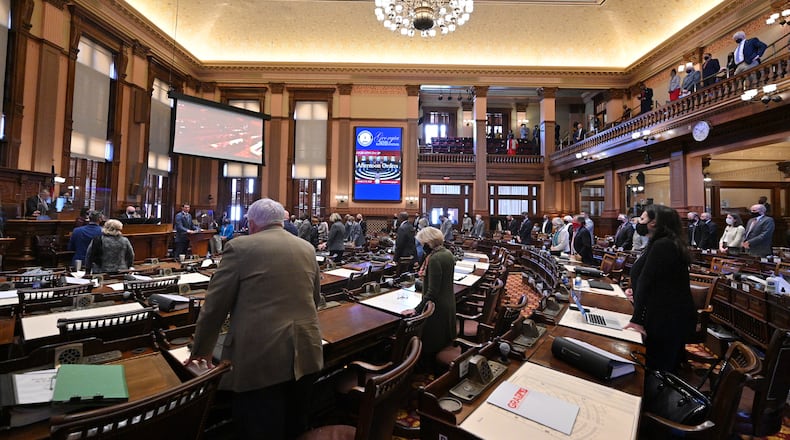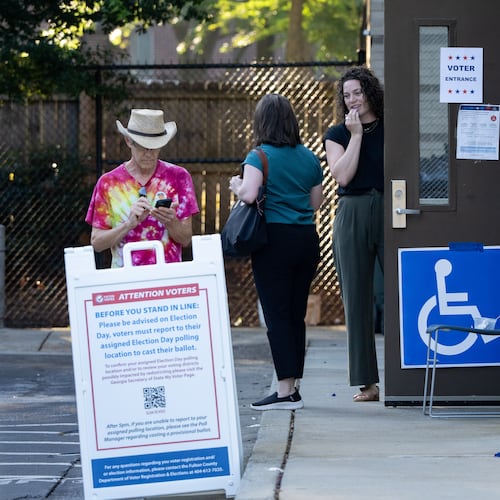Georgia has changed: It added 1 million residents over the past decade, saw shrinking white and rural populations, and witnessed Democrats winning statewide elections for the first time in over 20 years.
Those realities will drive decisions by the Republican-controlled General Assembly when it starts redrawing the state’s political maps next week in an intense and partisan process that will help determine Georgia’s representation in Congress and the state Capitol for the next decade.
At stake is power over every policy decision affecting Georgia, including taxes, voting rights, education, abortion and gun control.
The special redistricting session that begins Wednesday at the Gold Dome will be filled with contentious debates as Republicans try to preserve their majorities in a state whose voters are nearly evenly divided between Democrats and the GOP.
While Georgia has diversified over the past 40 years, its representation doesn’t reflect those shifts.
White legislators make up more than two-thirds of the General Assembly in a state that’s just 50% white, leaving people of color without proportional representation. A majority of white voters in Georgia typically vote for Republicans, and over 90% of Black voters generally support Democrats, according to exit polls.
Census data shows that nonwhites accounted for all of Georgia’s 11% population growth since 2010, but redistricting could prevent them from winning more seats in next year’s elections. Meanwhile, the state’s white population has slightly declined, and fewer and fewer people live in rural Georgia, where most of the General Assembly’s leadership resides.
“We’re in a state where people of color and the white community are very polarized” between Democrats and Republicans, said Karuna Ramachandran, campaign manager for the Georgia Redistricting Alliance, an organization advocating for racial minorities in redistricting. “What we’re going to see is a very partisan process to benefit the majority party.”
Lawmakers are required to reshape political lines so each congressional district in Georgia has roughly the same number of voters. The same is true for each state Senate district and each state House district. Districts have to be contiguous, and lawmakers should try to avoid “unnecessarily” drawing two or more incumbents into the same district, according to rules approved by the House and Senate earlier this year.
But regardless of those guidelines, the process often results in gerrymandering, in which legislators choose their voters by shaping districts in a way that maximizes their chances of reelection.
They won’t stop there.
The special session will also include hearings over whether Atlanta’s Buckhead community should become its own city, along with potential fights over the rise in violent crime and posturing by legislators preparing for next year’s elections.
At least 11 lawmakers have announced campaigns for higher office, and a few others are considering doing so. All 236 General Assembly seats and the state’s 14 congressional seats will be on the ballot in 2022.
While Georgia’s electorate was nearly evenly split between the two political parties in last year’s elections, Republicans, who hold 58% of the General Assembly seats, will be scrambling to solidify their control by redistricting Georgia in a way that stalls recent gains by Democrats, who attempted to do the same thing when they held power for decades.
“It’s an existential crisis for the Republican Party in the sense that the state is changing and they want to continue to be the dominant force in the Legislature,” said Benjamin Taylor, a political science professor at Kennesaw State University. “If they can get it done in a way the courts give an OK to, that will help them maintain power for some time to come. If they don’t do a very good job, then they could see their power ebb away much more quickly.”
Credit: AJC file photo
Credit: AJC file photo
Republicans say they will follow the law, making maps that are nondiscriminatory with equal populations in each district. But as the majority party, Republicans have the votes to pass what they want.
“Taking into account that they are the majority party, that’s not unfair. That’s politics,” said Ben Harbin, a Republican who was in the House for over 20 years, until 2015. “Maps are going to be more favorable to the majority party, but that’s the nature of this beast.”
Legislative leaders so far haven’t unveiled proposals for state legislative districts, and just days before the redistricting session is set to begin, the House hasn’t published a map for Georgia’s congressional seats.
But it’s likely that neither Republicans nor Democrats will be happy with the final maps — with some of the more conservative members of the GOP wanting their party members to go further to pick up additional seats versus trying to solidify their hold on the ones they already have. Also, despite the rules approved by the chambers, some lawmakers on both sides will be drawn out of their current districts, raising the likelihood they’ll have to run against a colleague in 2022 if they want to stay in the General Assembly.
Once maps are introduced, Republicans and Democrats will rush to pass them before Thanksgiving.
Senate Majority Leader Mike Dugan, a Carrollton Republican, said he expects legislative maps to pass each chamber relatively quickly.
“Those will be more straightforward,” Dugan said. “The congressional ones will be a little more involved.”
Noting that it was his first time going through a redistricting session since he was elected in 2012, Dugan said it is important to remember all the factors that have to be considered when drawing maps.
“Numbers are a piece of it. But historical minority areas have to be taken into account, maintaining the integrity of municipalities have to be taken into account, not pitting sitting members against each other as a way to force somebody out has to be taken into account,” he said. “You do have a margin of error that you can have between the sizes of the districts that you have to stay in and then balance the rest of the population across the state. So it’s a lot of work.”
Credit: Alyssa Pointer/AJC
Credit: Alyssa Pointer/AJC
Senate Minority Leader Gloria Butler, a Democrat from Stone Mountain, said she’ll push for maps that reflect Georgia’s political composition and allow communities to elect representatives that match their priorities.
But Butler and her Democratic colleagues lack the numbers to stop Republicans, who control the Senate, House and Governor’s Mansion. Republican Gov. Brian Kemp will have to sign or veto redistricting bills.
“I’ve prepared myself for what’s to come,” Butler said. “We don’t always get what we hope for.”
Credit: Alyssa Pointer / Alyssa.Pointer@ajc.com
Credit: Alyssa Pointer / Alyssa.Pointer@ajc.com
Much of Georgia’s growth has taken place in metro Atlanta, which is dominated by Democrats, while rural and more Republican counties have lost population.
As a result, metro areas in North Georgia will likely gain more seats in the Legislature, while South Georgia will lose some representation.
“Communities of color share similar values and interests and should have a right to elect candidates of their choosing,” said Jerry Gonzalez, CEO for the Georgia Association of Latino Elected Officials. “This legislative process should respect and honor both the growth of the electorate and population with fair districts drawn to the benefit of the communities that are driving the growth for our state.”
The draft congressional map pitched by the state Senate GOP Caucus demonstrates how Republicans could tighten their grip on power.
The map would enable Republicans to reverse recent gains by Democrats by drawing more GOP-friendly suburban areas into the 6th Congressional District, currently held by Democratic U.S. Rep. Lucy McBath. The district would spread north to encompass all of conservative Forsyth County, along with north Fulton and east Cobb counties. The current map covers parts of Cobb, DeKalb and Fulton counties.
Republicans hope they could gain a seat and retake their 9-5 advantage in Congress, which slipped to an 8-6 margin last year when Democratic U.S. Rep. Carolyn Bourdeaux won the 7th Congressional District in Forsyth and Gwinnett counties.
No matter what maps pass, they’re likely to be challenged in court.
The Voting Rights Act prohibits racially discriminatory maps. Several lawsuits have been filed over the years that challenged maps that have weakened Black voting power. Some objections have been successful, such as in the 1990s, when the General Assembly created additional majority Black districts to appease concerns by the U.S. Department of Justice.
There are other reasons maps can bring lawsuits. When Democrats were in power 20 years ago, the courts threw out their redistricting efforts because they created districts with populations that varied by nearly 10%. Then maps had to be redrawn, which helped Republicans dominate General Assembly elections in the following years.
Lawmakers are also expected to meet to discuss issues that aren’t related to redistricting. Republican lawmakers have said they will discuss ways to curb the recent crime surge in Georgia and a proposal to carve out a city of Buckhead from the rest of Atlanta.
State Sen. Brandon Beach, a Republican from Alpharetta, said he plans to discuss a draft of his Buckhead cityhood bill with a committee during the first week of the special session.
“I’ll present the bill, present the feasibility study and start laying the groundwork so that when we do come in session in January we can have another (hearing) and move it quickly,” Beach said.
Still, lawmakers’ focus will be on redrawing the state’s districts in enough time to get back home by Thanksgiving.
“This happens once every 10 years and there’s not many people in the chambers that have been through this before,” Dugan said. “So we think we know how it’s going to go, but we’ll know for sure here (this) week.”
How redistricting works in Georgia
States must redraw political boundaries for congressional and legislative seats once every 10 years to ensure that each has equal populations. Redistricting occurs after new population numbers are released as a result of the U.S. census. In August, the 2020 census provided detailed data for crafting new political boundaries.
The majority party in most states, including Georgia, then uses those population numbers to create new districts that help preserve their power. In Georgia, Republicans hold majorities in the state House and Senate, giving them the authority to draw district lines that maximize their chances of reelection.
When maps are released, they’ll be included as part of bills that move through the legislative process, with votes usually split along party lines. Then the new maps will be used by candidates running for Congress and the General Assembly in next year’s elections.
Keep Reading
The Latest
Featured







